Breastfeeding + BLW: How to Succeed at Both Simultaneously with Heather Dvorak, IBCLC
- How to succeed at breastfeeding when your baby starts baby-led weaning...and as a mom of 4 kids with food allergies (plus food allergies herself!) Heather has a wealth of information about continuing to breastfeed even if BLW is hard for you too!
- The natural progression to producing and providing less breastmilk during the weaning process as your baby starts to derive more nutrition from solid foods
- Strategies for parents who are breastfeeding/chestfeeding and want to continue doing so past the baby’s first year
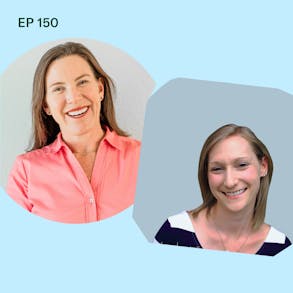
LISTEN TO THIS EPISODE
Episode Description
Fritters are an easy way to help your baby safely eat smaller pieces of food early on in baby-led weaning. You can incorporate cooked whole grains, proteins and various types of cooked vegetables in fritters that your baby can then self-feed. In this episode we’re talking about the components of a basic baby-led weaning fritter recipe as well as substitution ideas if your baby doesn’t eat eggs.
Links from this Episode
- Heather Dvorak, IBCLC’s website A Baby Place: Birth, Breastfeeding and Beyond can be found here
- La Leche League Joint Statement on Use of Term Chestfeeding is here
- What is an IBCLC (International Board Certified Lactation Consultant) informational statement from the IBCLE is here
- Baby-Led Weaning with Katie Ferraro program with the 100 First Foods™ Daily Meal Plan, join here: https://babyledweaning.co/program
- Baby-Led Weaning for Beginners free online workshop with 100 First Foods™ list to all attendees, register here: https://babyledweaning.co/baby-led-weaning-for-beginners

Latest Episodes
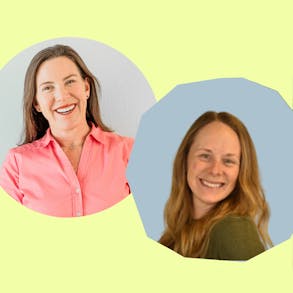
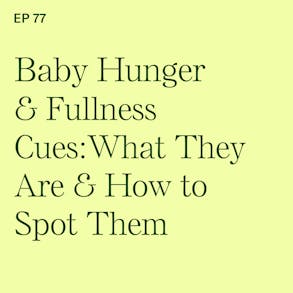
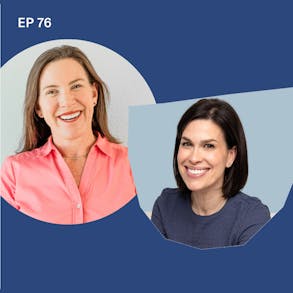
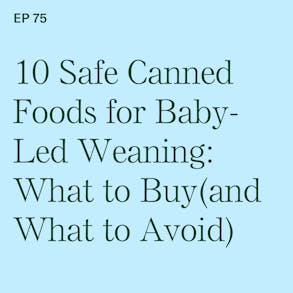

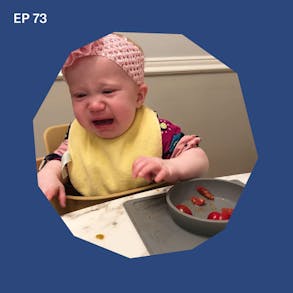
Heather Dvorak (0s):
The physical act of breastfeeding helps to develop the mouth and jaw helps to shape the palette. And it helps to tone the lips and cheeks and tongue all to help prepare babies for that natural transition into food as they get
Katie Ferraro (14s):
Bigger. Hey, there I'm Katie Ferraro, registered dietitian college nutrition, professor and mama seven specializing in baby led weaning here on the baby led weaning made easy podcast. I help you strip out all of the noise and nonsense about feeding, leaving you with the competence and knowledge you need to give your baby a safe start to solid foods using baby led weaning. Well, hello, And welcome back. And a very special welcome to all of the breastfeeding mamas who are out there. Listening, just getting ready to start your baby on this transition to solid foods. I know for most of you, your breastfeeding journey is not ending, but it certainly is going to be changing as you move to solid foods with your baby.
Katie Ferraro (1m 2s):
So in honor of world breastfeeding week, I wanted to rerelease one of the most popular episodes that we've ever had here on the baby led weaning podcast. This is episode number one 50 and after 150, one of the most downloaded ones was an interview with an IB
Heather Dvorak (1m 18s):
CLC named Heather Dvorak. Now Heather's going to be helping us strategize on how to succeed at breastfeeding while doing baby led weaning.
Katie Ferraro (1m 25s):
And I think you guys are really going to love Heather's down to earth approach if you haven't heard it before, but she's all about how to maximize success, both at the breast and the table, because I know this can be a stressful time for you. Like you've spent the last six months getting your whole breastfeeding situation figured out and things are going well. And now you've got to mess up the whole schedule and introduce solid foods. And I don't want you to feel overwhelmed by this next step. I want you to feel supported. I want you to feel like you can do this because you can. And that's exactly why I'm bringing Heather Dvorak back to teach all about succeeding with baby led, weaning and breastfeeding. And for those of you who are just starting out with solid foods, and this is all new, if you're struggling a little bit with what to feed your baby beyond the simple starter foods I wanted to let you know that I'm co-teaching to free live.
Katie Ferraro (2m 11s):
Baby led weaning workshops very soon with my good friend and feeding colleague Dawn Winkelman. Dawn is also a baby led weaning expert, but she's a speech language pathologist and a pediatric swallowing expert. So as the dietician, I teach all about what foods your baby can eat. And Don teaches you how they learn to eat. We're teaming up together to teach our workshop. It's called, what do I feed my baby after avocado banana and sweet potato? And this workshop is designed to help you push your baby past those simple starter foods. Because once you move off of the breast milk only diet and you start baby led weaning. I know you're going to hit some roadblocks and you're going to feel stuck on those simple starter foods and Don, and I don't want to see you do that.
Katie Ferraro (2m 51s):
We don't want to see you give up in offering your baby real food. So we're going to show you how to progress past those simple baby led weaning starter foods like avocado and sweet potato, and everyone on our free workshop actually gets a copy of one of our most requested infant feeding guides. This is our sample eating and drinking schedules for six, nine, and 12 month old babies. So you'll never worry about how often or what your baby should be eating or drinking at all the different new ages and stages. So if you want to sign up for the workshop again, it's called, what do I feed my baby after avocado banana and sweet potato? All you have to do is go to baby led, weaning workshop.com. Now with no further ado, let's get started learning how to succeed at breastfeeding and baby led weaning simultaneously with Heather Dvorak, IBCLC.
Katie Ferraro (3m 37s):
Heather, thank you so much for joining us today.
Heather Dvorak (3m 40s):
Thank you so much for having me.
Katie Ferraro (3m 41s):
So tell us a little bit about your self and your family. If you don't mind, we'll kind of touch on that before we jump into the professional side where you're helping other families with breastfeeding.
Heather Dvorak (3m 51s):
Absolutely. So I started out working out of college with children, birth to three, with developmental delays and disabilities. And when I had my twins, I developed a really strong passion for helping moms with breastfeeding. Breastfeeding was not easy for us. We really had to work at it. And I just got really excited about being able to help other moms and other families to accomplish their breastfeeding goals. So in back to school, when the twins were one and ended up getting pregnant with number three, just as I was beginning my clinicals. So that was really interesting and exciting. And now we have four little ones. Our twins are seven and a half. Our son is four and a half, and then we have a seven month old little boy as well.
Katie Ferraro (4m 33s):
Wonderful. Now, when we were speaking before the interview, we kind of went down this food allergy rabbit hole because you guys, we have to do a whole separate episode with Heather, her children and herself as well, have some pretty extensive food allergies. So if you don't mind just sharing briefly about their food allergies, because I think it will help. I mean, I think you're so amazing that you've been able to manage all of this with four different kids plus breastfeeding working, et cetera. But could you share just a little bit about your family's food allergy history?
Heather Dvorak (5m 1s):
Absolutely. So with the twins, it took us a little while to figure out what was going on with them. We ended up discovering that Kaylee, our twin a has a significant sensitivity to gluten and then twin B, Ava is allergic to both dairy and soy and she has since outgrown those allergies. It took a little while, but we got through it with elimination. And then by the time she was five, she had outgrown both of them. Then with number three, Mr. Grayson, he had a whole host of food allergies. At one point, the allergies had found 19 things that we had to stay away from. And over the course of his four and a half years, we've been able to slowly reintroduce almost everything as his system is healed.
Heather Dvorak (5m 42s):
And now with little Sammy who was our youngest, we have also discovered quite a few food sensitivities and are working really closely with his allergist to approach introducing foods in a way that's going to help best support his gut health and being able to do a of textures and flavors while we're figuring out what he's reactive to.
Katie Ferraro (6m 2s):
Oh my gosh. That's a lot to deal with. You are amazing. And I know that when we were introduced to each other, you had just started solid foods with baby Sammy. So again, he's seven months of age. And do you mind telling us a little bit about your first experience with avocado with him who you had previously? I think said he'd had a little bit of a reaction when you had had oats and he'd had some symptoms, but other than that, you weren't really aware of any existing food allergies. What happened when you started solid foods with Sammy?
Heather Dvorak (6m 28s):
So when we started the avocado is Sammy. He was really excited about eating, which was new in the past with our kiddos, we would put the food on their tray and we would just let them play with it. And they would make giant messes and have a grand old time, but really didn't actually get anything in their mouth. Sam, you seem to really understand this concept and he was all about eating. So he picked up his little pieces of avocado and put them right in his mouth. And sure enough, about six hours later, we had our first bloody diaper. So that was our cue that we needed to step back and hold on a second and figure out what was going on with that. So we reached out to our pediatrician who said, you know what, let's change directions. And let's try starting him off with some pasture-raised chicken broth.
Heather Dvorak (7m 9s):
So we switched over to making our own chicken broth, getting chicken straight from the farm so that we can make sure that nothing had been done. And he did great with the chicken broth. And then we were able to introduce the actual shredded chicken. And now he's moved on to carrot and broccoli.
Katie Ferraro (7m 25s):
She's still able to try new foods. And it sounds like you have a really nice relationship with your allergist, who is giving you a list in a variety of different foods, as well as textures that your baby can successfully try and something that you said when we were speaking before the interview that I thought really resonated with me was that you guys have chosen to focus on all the foods that your children can eat. Cause I was like, oh my gosh, this list of all these foods, that four different kids can't eat, how overwhelming. And I think that's such a positive message that you're sending them. There are foods out there that our kids can eat. Although I can imagine that some days it feels again quite overwhelming since they are to some degree restricted. Yes.
Heather Dvorak (8m 2s):
There are definitely days where I'm like, oh my gosh, what do I feed you? And sometimes we end up with four different dinners, but usually we can find something that works for everybody and is moderately convenient.
Katie Ferraro (8m 14s):
I know that as an IBjust-foodCLC. So you're again, that's an internationally board certified, you're a lactation consultant. You have spent a lot of time thinking about infant feeding. And it was just curious if you could share, what is your general philosophy about starting solids and breastfeeding?
Heather Dvorak (8m 31s):
Well, I feel like breastfeeding is all about watching our baby's cues and following their lead and feeding on demand. And we really focus on letting our babies drive the process when it comes to breastfeeding, as long as they're doing well with their weight gain and their diaper output, we know that they can be really in charge of that process and they can follow their hunger cues and we can let them guide our path. And I feel the same way about baby led weaning and starting solids that when we allow our babies to just drive that whole process and be the ones who set the speed that they often do very well. And it's a very natural progression. As we begin to introduce those solid foods and babies naturally start to eat increasing amounts of solids as they very naturally slowly start to decrease the amount that they're breastfeeding over that first year, year and a half.
Katie Ferraro (9m 20s):
And I love that you mentioned it's a natural progression and it's rather slow. You guys, this doesn't happen overnight where your baby wakes up on their six month birthday. And they magically know that there's time to eat food and they start weaning off their breast milk or wake up on their first birthday and magically know how to eat a hundred different foods. And now they're ready for cows milk. All of these things take time. And so I like that idea of progressing from the baby is driving breastfeeding to the baby is driving food. And to be honest, I feel like it actually makes less work for us as parents. If you're allowing the baby to be in charge of the important things like how much or even whether they decide to eat, how else would you say that breastfeeding perhaps helps prepare babies for baby led weaning?
Katie Ferraro (10m 3s):
Are there other things that we're doing in breastfeeding that we don't even realize that are actually gonna translate well when it comes to starting solid foods?
Heather Dvorak (10m 11s):
Absolutely. So there's a few different, I mean, there's a ton of different things, but the physical act of breastfeeding helps to develop the mouth and jaw helps to shape the palette. It helps to tone the lips and cheeks and tongue also helped prepare babies for that natural transition into food as they get bigger. The other really amazing thing about breast milk is that flavor passes through. So the foods that we eat help to flavor our milk and that introduces our babies to the flavors of our culture, that helps our babies be receptive to the foods that we offered to them. But it also exposes them to such a large variety that are really significant for creating adventurous eaters in the future.
Katie Ferraro (10m 51s):
That's amazing. And I think sometimes we forget that those flavors pass through breast milk to the babies, and sometimes parents feel that they need to start with such a bland diet and we can actually season and flavor our baby's food. Of course, we want to avoid excessive salt and excessively spicy foods, but your baby has already been exposed to many of these flavors, even in utero during breastfeeding. So keep up that variety. As you start with new foods, you don't have to be super bland. You can season your baby's foods as well. So Heather, for those moms out there who spent a lot of time building up their milk supply, or maybe they've struggled with getting to a place where they feel that they have adequate milk supply or they're supplementing with formula, what recommendation or thoughts or advice would you have for coping with this weaning process?
Katie Ferraro (11m 36s):
As we introduce solid foods,
Heather Dvorak (11m 38s):
I think meaning can sometimes be a confusing word when we spend our first six months focusing on just providing breast milk and or formula. And then we begin to introduce food. That is what we refer that's winning really means is just that introduction to solids and slowly, gradually increasing their solid intake over the next six months. So we give them six months to figure out how to eat effectively. And during that time it's a really natural, gentle progression as they become increasingly more proficient with their solids, that they'll just slowly begin to naturally take a little bit less milk and it takes months for that to happen.
Heather Dvorak (12m 20s):
It's definitely not an overnight thing, but over the course of six to 12 months, they become pretty good at eating food. And then over the course of the next few months, they really transitioned from breast milk or formula being their primary source of nutrition up to a year to then it becoming the complimentary source of nutrition and breastfeeding can continue for as long as families are providing breast milk can continue for as long as families want after the age of one. But by one we're hoping that our babies are pretty good at eating food and they're getting the majority of their necessary nutrition that way. And then the breast milk is really our, our safety net. It's our way to make sure that they're getting everything possible and we get to follow their lead.
Heather Dvorak (13m 1s):
As they tell us how much milk they need versus how much solid thingy
Katie Ferraro (13m 5s):
I love that you mentioned an important point that up until about six months of age, breast milk or formula really is all your baby needs. A lot of parents that I've worked with are so either excited about starting solid foods or they're being pressured into starting solids too early. And I always like to remind them that prior to six months of age, not only is it not safe for your baby to be eating solid foods because physiologically they're not developed or enough or ready to handle anything except breast milk or formula. But really I think perhaps even more importantly, there's no need to do that because the breast milk or the formula is deficient. However, starting around that six months of age time period, when your is showing the other signs of readiness to feed it is time to start introducing those complimentary foods because they will provide that nutrition, the little extra nutrition, that breast milk and formula, although it's still wonderfully nutritious and still will be the majority of your baby's nutrition for the next few months, we do need to start incorporating nutrients from outside sources like food.
Katie Ferraro (14m 3s):
So again, like Heather said, it's this gradual progression. And you mentioned earlier how you like the term complimentary. Do you think you could maybe just shed a little more light on how foods compliment breast milk once we move past six months of age? Yeah.
Heather Dvorak (14m 17s):
So for the first six months, breast milk is primary and then the food kind of comes alongside of the breast milk and just adds a little bit of extra. And over the course of that six months, you start to see the food increasing and how much they're getting nutritionally and calorically and the breast milk slowly, very gradually begins to decrease. So all of that work that moms have done to build up their milk supply is so incredibly important. And your supply is going to continue to really gently evolve alongside your baby's skills with solid food. So that food is just a compliment. It's a little bit of an increase above the breast milk and then slowly the breastmilk begins to drop as the food increases.
Katie Ferraro (14m 58s):
Beautiful. So I think that's, if, if everything goes bright, that's ideally how things would shake out. But let's switch gears and talk a little bit about some of the complications, because I know a lot of our listeners have struggled with breastfeeding and experienced things like mastitis or blebs plugged ducts or other breastfeeding issues. How would you advise these moms when they are undertaking baby led, weaning and breastfeeding so that those issues don't arise again,
Heather Dvorak (15m 24s):
I think there's two different roads that we have to consider with this. So if we've got a baby that's primarily being fed at the breast, then that mom has potentially developed a very significant milk supply and is concerned about decreasing the amount of milk that's removed from the breast, because that can increase our risk of plugged XMS status. So if we've got a kid with primarily feeding at the breast, the amount of solids that they take over that first month is going to be pretty minimal over the second month, that's going to be a little bit more. And by the third month they're going to get pretty good at it. And by the fourth month they might actually be eating meals. So from six to 10 months, the volume of breast milk is going to stay pretty constant.
Heather Dvorak (16m 7s):
It's going to decrease ever so slightly over time, but not a whole lot. And then between 10 and 12 months, the volume will decrease again a little bit more rapidly at that point, but it's a really, really gradual process. And that helps protect the breasts from developing plug ducks and mastitis, because it's such a gentle process. Now, if we have a mom who's doing mostly pumping during the day, because she's not with baby or because she's exclusively pumping, then we have to do that process on our own. We actually have to be the ones who do that process. So we're not going to decrease the amount that we're pumping in any rapid fashion, but we might find, Hey, I seem to be having a lot of milk left at the end of the week.
Heather Dvorak (16m 48s):
So maybe instead of me pumping for 20 minutes, I'm going to hump for 18 minutes. And then, you know, I still have a ton of milk left at the end of the week. I think I'm going to drop it down to 15 minutes and we do this very gradually so that we, in a sense simulate the natural weaning process that abies do over those months.
Katie Ferraro (17m 5s):
So you're talking about in pumping, reducing the duration of the pumping session. At what point do you then also decrease the frequency of the pumping? So the number of pumping sessions a day at the same time simultaneously, or does it vary?
Heather Dvorak (17m 20s):
It really depends on the family. It depends on the mom. It depends on the baby. If mom tends towards plugged ducks, we do a very gradual process where we just dropped down the minutes of the pumps that she wants to eliminate, or we can lengthen the time in between those pump sessions. So instead of pumping every three hours, we're going to pump every three and a half hours, and then we're going to pump every four hours. And that naturally will eliminate some of our pump sessions over time. But we do this really gently so that we can sure that we protect mom's health. In addition to making sure that we're providing as much milk as we need,
Katie Ferraro (17m 55s):
That you are really focusing on the individual goals of the family, because we all have different goals. And so when parents ask me a specific question, especially if they're incorporating breastfeeding with baby led weaning, I always like to leave with, well, what's your goal. Like I know personally with my quadruplets, I only ever pumped enough for half of them. So I always had to do half breast milk and half formula and I would mix it, but I did that for six months. And I remember like at the six month adjusted age being like I'm done, I cannot do this anymore. And so did a much more, I would say less gradual weening myself, just because my own personal goal was to get them to six months. But beyond that, I couldn't do it. And that was my own goal. And there's another quadruplet mom out there who might go a year and other ones who never did again, there's no right or wrong way to do this.
Katie Ferraro (18m 40s):
It's based on your goals and the goals for your baby as well. And I felt confident at the six month adjusted age mark, when they started solid foods, like I've done what I can here, as far as the breast milk goes. And now I really want to be able to focus on the foods, but again, that's not what works for every family. So I love that you're embracing this idea of having personal family goals. I might have only made it six months with certain kids, but there's moms out there, especially the ones that want to breastfeed until at least one year. But they're not sure if they want to continue beyond that. Heather, what would you tell them about the benefits of breastfeeding beyond one year, if that is part of their goals or something they envision themselves doing well, first
Heather Dvorak (19m 17s):
Let me say how incredibly amazing it is that you explicitly pumped for six months adjusted, which was even longer than six months actually. Well, secretly
Katie Ferraro (19m 25s):
I just wanted like a break from them. Like every, you know, like I gotta go pump. Like it was like literally my vacation. I love pumping because I got to break for the babies.
Heather Dvorak (19m 33s):
Well, if my hat is off to you, explicitly pumping is such a labor of love. And to make it making 50% of their milk for six months is just incredible. And it's something that you should be truly, truly proud of.
Katie Ferraro (19m 46s):
Oh, you are so dice because you don't actually always said, I always thought after that, I was like, well, I'm making half, like a, basically from the time they were born and they were preemies made 50% of their needs at all times. So I always thought, gosh, if I have twins, then at least I'll make enough breast milk. And then a year and a half later I had twins and barely made enough for them. And I was like, this is ridiculous. Like, I think I was getting older and more stressed, but I was one of the people that actually loved pumping. Like I literally liked pumping because I'm like a schedule person and efficient person and my hats off to anyone who breastfeeds multiples. I know you said you breastfed your twins. It is. I tried the tandem breastfeeding and I was like, this is not for me. Good thing. I love pumpkin.
Heather Dvorak (20m 24s):
I think we all find our way hopefully. And hopefully we have someone to help us find our way. So to answer your question about nursing or providing breast milk beyond a year. So the American academy of pediatrics recommends that babies be provided with breast milk until the age of one. And then as, as long as mutually agreeable between mom and baby, the world health organization recommends age two and parents always ask me, how long do I recommend? And honestly, I recommend that you provide breast milk for as long as it works for you and your baby. However long that is, is what you should do. So for families that choose to provide breast milk after the age of one are focused switches over from breast milk, being our primary source of nutrition and the solids being complimentary to the breastmilk becoming complimentary and the solids becoming primary, like we talked about before, but breast milk never loses its nutritional value.
Heather Dvorak (21m 16s):
It is always beneficial to our babies. So providing it for as long as we want in whatever quantity we choose is still going to have health benefits for our children. Breast milk is so much more than just food. So the act of breastfeeding or chest feeding is an opportunity for bonding. We talked a little bit about that oral motor development that continues. It's also just an opportunity for checking back in with parents and, you know, continuing that connection. As far as the nutritional component, it's a great safety net for the pickiness that toddlers sometimes develop. But we hope to avoid that with getting them to a hundred foods and, you know, following your plan really does help babies to become very open-minded about the foods that they will eat.
Heather Dvorak (21m 59s):
But after a year, the other benefit to continuing to provide breast milk are antibodies. And, you know, we're in a time right now where we're really focused on boosting immune systems and kids are introduced to all sorts of wonderful bacteria and viruses as they explore the world around them, licking, you know, everything around equipment and Jews and all sorts of other things. So knowing that we've got the antibodies and our breast milk is another great reason to continue to provide that beyond a year, if that works for the family.
Katie Ferraro (22m 29s):
Okay. So I love the idea of going beyond one year, if that works for your family, if you are done earlier and your baby's done earlier, some babies kind of make the decision for us. There's the mom, Rachel, that I was communicating with recently. And she's like, can you ask Heather how to talk about incorporating breast milk around age one Rachel's little guy is almost one, he's a great eater. And she says he almost prefers food to milk. Some days he's actually almost at a hundred foods, but mom is still exclusively pumping full time. So she's not confident about this transition, any words of advice for her as she kind of navigates getting to that one year phase with baby led weaning, baby, who's doing well on food, but she's still exclusively pumping.
Katie Ferraro (23m 10s):
What should she do next?
Heather Dvorak (23m 11s):
Well, first of all, awesome job exclusively pumping two a year. That is such a tremendous, tremendous accomplishment. At this point, as baby starts to choose to have less milk, we really just want to follow his lead. So we want to offer that milk, whether it's in a bottle or in a cup with each meal, generally I recommend offering the milk before solids, maybe about 30 minutes before, and then sitting down for our meal of solids, just so that we can encourage that continued consumption of the milk, but for some families by 11 and a half months, we're giving those breast milk cups with our meals. And we'll start to see that baby will naturally take less. And if mom continues, if Rachel continues to pump, she'll continue to be able to give that milk through a cup or a bottle.
Heather Dvorak (23m 56s):
I really liked Strat cups. I love open cups for water, but I feel like we work so hard for that breast milk that I would hate for them to spill it all over the floor. So we can put small amounts and open cups, or we can put it in a straw cup and just follow her little one's lead in terms of how much milk he wants. And that may change over time. So there may be some periods over the next month or two, where he takes a lot less breast milk. And then there will be periods where he'll start taking a lot more and he might take a little less solids. And if we just let him guide that process, he's going to find his way and show us what he needs. Nutritionally. We really do know that that children, when left to their own devices will eat and drink what their body needs.
Katie Ferraro (24m 38s):
I love that. And when I think I always was confused on when I was a new mom, was you think about your baby's getting bigger. So everything will be required in greater quantities. Like think about diapers, you start with the newborn, then size one and size two. Then like they go to as big as the diaper sizes. And then you're like, okay, I'll potty train. Now, at least that's how I am. But with formula and breast milk or whatever combination you may be doing of the boat, it levels off and tapers off. And I remember being so like, wait a minute. At eight months of age, my baby's kind of drinking the same volume of fluid that she did when she was six months of age, but she's getting bigger and she should be drinking more. And then it kind of dawns on you like, well, wait a minute, no, this is the natural progression. It will level off. They will not continually escalate the volume of milk that they're drinking because now you're incorporating solids and it starting to take up more of her starting to provide more of their nutrition.
Katie Ferraro (25m 25s):
So do kind of think of it as almost like a leveling off. And one thing we actually want to avoid as babies move into the second year of life is there's especially with formula fed babies who are very proficient at drinking out of a bottle, there's the tendency to overfeed milk. And so as they move into the second year of life, when we switched to cows milk, if you're going off of formula, there's the potential for the baby to drink too much milk at which point milk is, has no iron it's displacing other potentially nutritive foods. It could be actually causing your baby to become iron deficient because they're then not eating iron rich foods. So I know that as breastfeeding moms, it's a little bit harder because they don't have an actual, like visual on the number of ounces at the baby's eating the pumping moms really do.
Katie Ferraro (26m 8s):
But if you are pumping or if you're feeding out of a bottle, you're combining with formula, just pay attention to the volume, knowing that as you go into that second year of life, somewhere between 16 to 24 ounces is where we want to see your baby. So if you're dramatically over that prior to the 12 month mark, that's another thing to look at potentially kind of maybe backing off the volume of milk as your baby gets more proficient at eating food. So Heather, I just want to say thank you so much for your time for sharing your expertise with us. You are an amazing wealth of knowledge, but also that you've done. Baby led weaning with your four children with breastfeeding, with all of the food allergies. Tell us where we can find out more about your practice and learn more about you.
Katie Ferraro (26m 50s):
So our
Heather Dvorak (26m 51s):
Practice we're based in Chicago, or just outside of Chicago, we're in the suburbs and we provide both in-person and virtual support to families all over the place, myself and my independent contractor, Amanda, but she's our primary tele-health person currently. And I'm kind of the primary in-person person, but we both do both. And our practice is called a baby place, birth, breastfeeding, and beyond. And you can find us online at a baby place, bbb.com. We are here really just to meet families wherever they're at to support their breastfeeding and chest feeding goals. We'd love to be of service if we can help in any way.
Katie Ferraro (27m 32s):
Cool. And I'll go ahead and link up your site and resource as well on the show notes for this episode, if you guys go to the website for this podcast, it's BLW podcast.com. If you search for Heather's name, her last name is <inaudible> D V O R a K. So Heather, thank you so much. I really appreciate your sharing your time with us and for all of the great information about how we can combine breastfeeding with baby led, weaning and succeed at both simultaneously. Thank you so much for having me. I hope you guys enjoyed that interview episode with Heather Dvorak IBCLC. All about how to succeed at breastfeeding and baby led weaning simultaneously. You can check out all of the links that Heather mentioned in this episode on the show notes page at blwpodcast.com/150.
Katie Ferraro (28m 21s):
And I'm also going to go ahead and link to that free live online workshop that I'm co-teaching with Ms. Dawn SLP, that workshop is called, what do I feed my baby after avocado banana and sweet potato? Come take the workshop. If you're not sure what to feed after you make the transition to solid foods. Cause those simple starter foods, we don't want you to get stuck on them. And everyone on that free workshop with me and Dawn, don't forget you get a copy of one of our most requested infant feeding guides. That's the sample eating and drinking schedules for six, nine, and 12 months. Again, we'll link everything up on the show notes page for this episode at blwpodcast.com/150. If you want to take the workshop, make sure you sign up now the live workshops that I co-teach with Dawn, they always fill up.
Katie Ferraro (29m 3s):
So I want to make sure that you can grab your spot again. That's at blwpodcast.com/150.
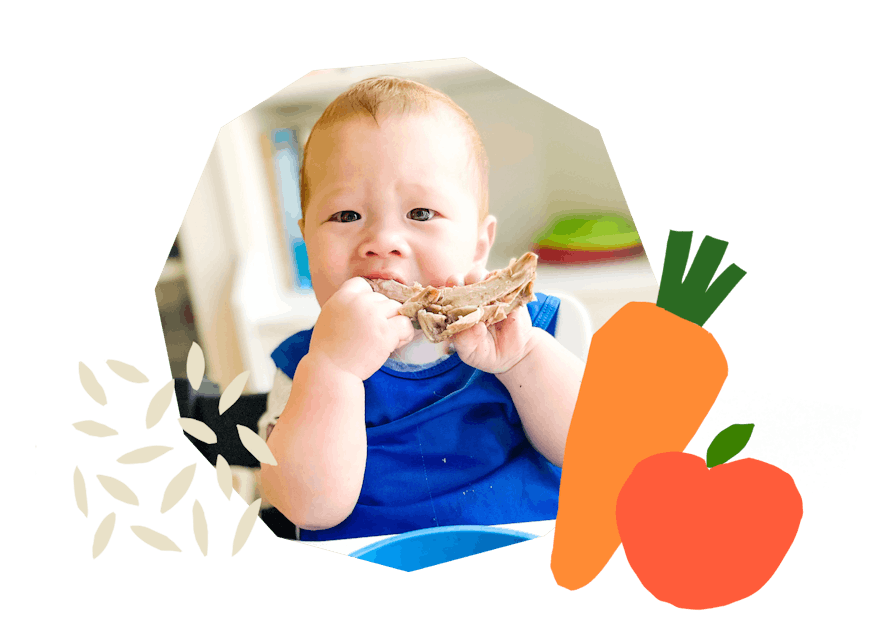
The Program Baby-Led Weaning with Katie Ferraro
A step-by-step digital program for starting solid foods safely and navigating the original 100 FIRST FOODS™ meal plan with baby-led weaning.
 EXPERT-LED, PROVEN APPROACH TO EATING REAL FOOD
EXPERT-LED, PROVEN APPROACH TO EATING REAL FOOD CONCISE VIDEO TRAININGS TO MASTER BABY-LED WEANING
CONCISE VIDEO TRAININGS TO MASTER BABY-LED WEANING 100 FIRST FOODS DAILY MEAL PLAN WITH FOOD PREP VIDEOS
100 FIRST FOODS DAILY MEAL PLAN WITH FOOD PREP VIDEOS
Baby-Led Weaning for Beginners Free Workshop
Is your baby ready to start solid foods, but you’re not sure where to start? Get ready to give your baby a solid foundation to a lifetime of loving real food…even if you’re feeling overwhelmed or confused about this next stage of infant feeding.
Get baby-led weaning recipes and tips delivered to your email inbox.

